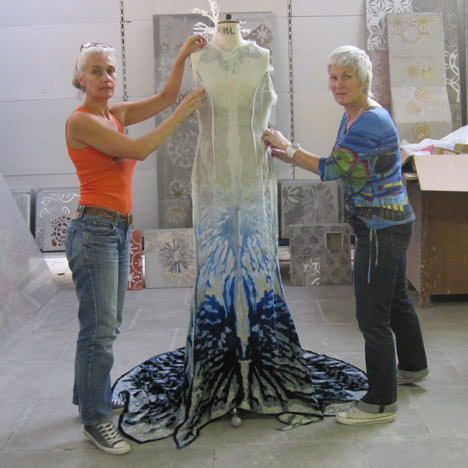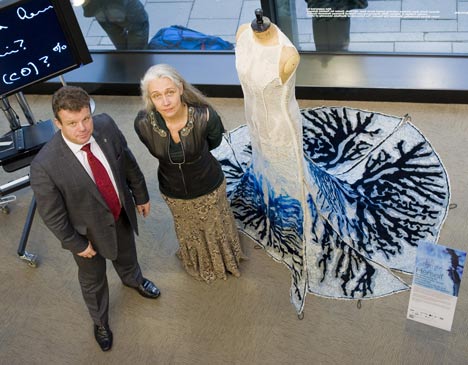Catalytic Clothing by Helen Storey and Tony Ryan
This movie by Adam Mufti features supermodel Erin O'Connor wearing a dress that incorporates a catalytic converter.
This is the first part of a collaboration between designer Helen Storey and chemist Tony Ryan to create clothes that filter pollution from the air. Music is by Radiohead.

Top image is copyright Adam Mufti
The dress is impregnated with a photocatalyst that uses light to break down air-borne pollution into harmless chemicals.

This substance could be added to clothes as part of the fabric conditioner in a normal washing cycle.

Here are some more details from Catalytic Clothing:
Catalytic Clothing
Catalytic Clothing is a radical project that brings together the worlds of fashion and chemistry with the potential to clean the air we breathe. Employing existing technology in a new way Catalytic Clothing seeks to explore how clothing and textiles can be used as a catalytic surface to purify air.
Catalytic Clothing is the brainchild of artist / designer Professor Helen Storey MBE and chemist Professor Tony Ryan OBE – two people inhabiting two very different worlds who are using their diametric approaches to achieve great things. Catalytic Clothing is an exciting venture that has the power to change the way we live and in the process contribute to making our lives greener and more sustainable.
It harnesses the power of a photocatalyst to break down air borne pollutants. A catalyst is a term used to describe something that makes a reaction proceed at a greater rate but isnʼt actually consumed during that reaction. A photocatalyst gains the energy it needs to be active from light.
The two biggest sources of air borne pollutants are industry and motor vehicles. Although the majority of the pollutants are prevented from reaching the air, using technology such as catalytic converters, some do escape. It is these pollutants that Catalytic Clothing will break down.
When the light shines on the photocatalyst, the electrons in the material are rearranged and they become more reactive. These electrons are then able to react with the water in the air and break it apart into 2 radicals. A radical is an extremely reactive molecule. These radicals then react with the pollutants and cause them to break down into non-harmful chemicals.
The Catalytic Clothing technology is designed to breakdown the pollutants straight away. However, some pollutants may become attached without being broken down. In this case, the pollutants will be washed off during subsequent laundering. This actually already happens with normal clothing.
Photocatalysts have been incorporated into several commercially available products that possess de-polluting properties. These products include paints, cements and paving stones.
The photocatalyst is delivered to the surface of the clothing during the traditional laundry procedure as an additive within a standard product such as a fabric conditioner. The active agent is packaged within a shell that is attracted towards, and subsequently binds to, the surface of the clothing during the washing cycle.
Why do we need mass participation to produce a noticeable reduction in the level of pollution? Although any garment that is treated with the product becomes active, a single garment is only able to remove a small proportion of the air borne pollutants. Therefore, a large number of individuals, all acting together, is required to produce a noticeable reduction in the level of pollution. An estimate of the required level of uptake for the Catalytic Clothing indicates that a significant reduction in the level of air borne pollutants in a large city such as London could be achieved if, for every metre of pavement width, 30 people wearing Catalytic Clothes walked past each minute.
Exposure to air borne pollutants presents a risk to human health and also has a detrimental effect on ecosystems and vegetation. Air pollution is currently estimated to reduce the life expectancy of every person in the UK by an average of 7-8 months. The widespread introduction of Catalytic Clothing would dramatically reduce the level of air borne pollutants, thereby improving the quality of life for all members of society. The Catalytic Clothing technology wonʼt actively attract any pollutants. Instead, it will break down anything that comes within very close proximity of the photocatalystʼs surface.